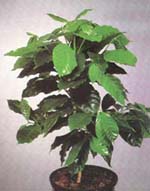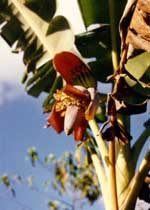|
FEATURED ARTICLES How to Grow a Coffee Plant
It is a small tree or shrub,
in nature up to 10 feet (3m) high; in cultivation kept smaller to facilitate
harvesting. It has opposite leaves. They are. short-stalked,
shiny and leathery, oblong- ovate in shape. The lateral branches
are somewhat arching. The pure white flowers are arranged in groups of
5 to 15 in the leaf axils of the. lateral branch. They exude a fragrant
jasmine- like scent. The flowering time. is usually restricted to a few
hours, during which time the shrub looks as if it is covered
in snow. From the ovary develops a two-seeded berry, green at first and
dark red when ripe. The ripening takes about 12 months indoors. If kept indoors, the plant
should be put into a cooler room in winter. It should certainly not stand
on the radiator shelf. The coffee plant needs a humus well-drained soil.
Standard potting Growing Bananas Indoors Invariably,
every indoor garden enthusiast comes to yearn for more exotic plants. One
of the most exotic, the banana is one of the simplest to grow indoors.
Originally native to Southeast Asia, bananas are now found in most tropical
and subtropical zones. It was the Roman Emperor Musa who first started
exporting bananas after he tasted its delectable fruit, which is where
the Latin name of the plant comes from. Bananas multiply by underground
rhizomes, from which new stocks grow, each producing one flower cluster
and fruit. The stalk can take 9-18 months to grow and another 4-8 months
for the fruit to mature. Fertilizers rich in potassium speed up the fruiting.
Suckers, continually being sent up from the base of the mother plant can
be removed to start a new banana tree. After a stalk has fruited, allow one replacement sucker to grow because the main stalk will die after fruit has matured. Bananas are self-fruitful and do not need a pollinator. If you live in a tropical or subtropical climate banana species are in abundance and there are many to choose from. Most people who live in temperate zones acquire bulbs or seed from various mail order contacts. The most common banana grown for indoor use are ornamentals and the fruit they bear are pretty to look at but not palatable. Bananas seeds like most others prefer a warm moist area of growth, soil content must be porous, and well drained, (acidic growing mix with a pH between 5.5- 6.5) When seed sprouts allow itself to grow into its container before transplanting it. When you see several shoots make their appearance, apply into a deep and broader container Do not cover the corm, (the part where the stocks grow) entirely. The top 20 % of the corm remains exposed to the outer air until the new plant has grown into its production of several bigger fronds. Bananas need ample amounts of water because of their large leaves, a gentle misting every few days will help though it is important that you do not over water your plant. Fertilize banana about once a month with a water-soluble fertilizer; try kelp or even fish food. Feeding is very important when the plant is maturing. Bananas thrive in bright indirect sun, a good southern exposure is beneficial, and although they will still grow in less sufficient light but might not flower and fruit. Several Hydroponic dealers and hardware stores carry various indoor light sources for a remedy to this situation. Avoid freezing temperatures or drafty locations. Temp not below 60F (15C). Ideal for outdoor patios during the summer time, in a shaded noontime area, make sure you check for insects before returning indoors. Good indoor (dwarf bananas) from our catalogue include Purple banana Catalogue #92 (musa velutina) and Zebra banana Catalogue #140 (musa zebrina)
Back issues of Exotic Gardening Newsletter are available for $2.00 per copy. Send a cheque or money order payable to Rainforest Seed Co. Canada SOME OF THE ARTICLES INCLUDED IN PAST ISSUES:
|
 Coffee
is a native of Ethiopia but is today cultivated throughout the world.
South and Central America, and Africa are the areas of greatest commercial
importance.
Coffee
is a native of Ethiopia but is today cultivated throughout the world.
South and Central America, and Africa are the areas of greatest commercial
importance.
